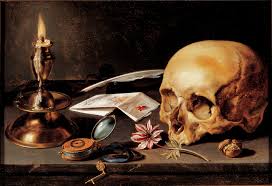
Original oil painting by Frans Hals, 1625 typifies the Vanitas genre with symbolic images of a nearly-extinguished candle, a wilting flower, and of course, a skull. Photograph from Wikipedia Commons.
When photographic techniques and equipment were developed, artists declared that the art of painting was dead. Oh no! they cried, we cannot compete with the accuracy of the photograph!
They were right. But instead of packing up their canvases and sneaking away into oblivion, they moved from realistically copying actual objects, to depicting things not as they are but as they seem, or in conveying feeling and sensations, or in translating intellectual thought into visual expression. Symbols became even more important in artists’ work, and human skulls, that had been a subject of artists’ explorations for almost as long as there have been artists, gained even more importance.
The uses of skulls as art are in the earliest records of human expression. From Asia, ancient Buddhist and Hindu traditions include the use of skulls. Cannibalistic tribes from the islands of the East used skulls (mostly of their defeated enemies) for ritualistic use and for artistic expression, not to mention as a source of dinner.
In the New World, Aztec and Toltec cultures made use of the skulls of defeated enemies and sacrificed slaves in tzompantli (racks for displaying large numbers of skulls). The Toltec people used carved skulls in jewelry and also in depictions of their gods and goddesses.
During the late Middle Ages of Europe, skulls were such a popular subject that certain styles were assigned “schools” that focused on specific aspects of skull art; these symbols served as a kind of shorthand to convey meaning to the viewer.
Paintings in the memento mori (Latin: remember that you must die) school depicted religious figures or events and featured items that show how fleeting – and vain – is earthly life. Saint Jerome, known for his writings about the rewards and punishments that await us, is often shown holding or sitting close to a skull.
Danse Macabre, taking its title from and originally depicting real events enacted at some funerals, show a dance or parade of figures that may all be dead (skeletons) or alternate between the living and the dead, to show the leveling power of death as well as its inevitability for us all.
Vanitas paintings are still lifes that also use skulls – and other objects with universally recognized symbolic meanings of passing time, the vanities of youth, etc. such as drooping flowers, hourglasses, watches, or nearly extinguished candles – to convey a message.
The use of skulls as subject matter in art continues in today’s wide-open art scene. Techniques, styles, and media change, and today skulls in art range from the beautiful, slightly stylized animal skulls of Georgia O’Keefe’s paintings to a glitzy platinum-cast human skull covered with more than 8,600 diamonds by artist Damien Hirst (2007), but the meaning and symbolism have not been diminished by skulls’ long history or it varied applications.
It just goes to show, you can’t kill off good art… or bury a symbol with the body!
